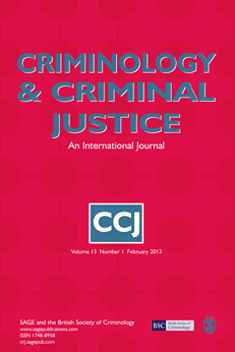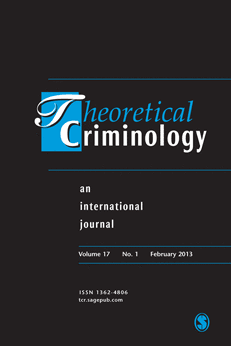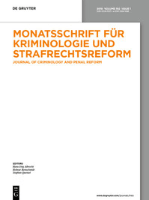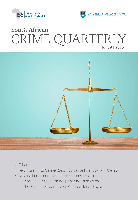
Russian Journal of Criminology
Scope & Guideline
Unveiling innovative research in criminology and social sciences.
Introduction
Aims and Scopes
- Criminal Law and Policy Analysis:
The journal emphasizes the examination of criminal law frameworks, their effectiveness, and the implications of legal policies on crime prevention and prosecution. - Criminological Research and Theory Development:
It promotes theoretical advancements in criminology, exploring diverse perspectives on crime causation, victimology, and offender profiling. - Emerging Technologies in Crime Prevention:
Research related to the role of new technologies, including AI and digital tools, in crime investigation and prevention is a key focus. - Transnational and Comparative Criminology:
The journal addresses comparative studies in criminology and criminal law, particularly in the context of post-Soviet states and international legal frameworks. - Social Issues and Crime:
It investigates the socio-economic and cultural factors influencing crime, including the impact of domestic violence, youth crime, and corruption.
Trending and Emerging
- Digital and Cybercrime:
There is a significant increase in research concerning digital crimes, cyberbullying, and the implications of technological advancements on criminal behavior and law enforcement. - Environmental Crime and Security:
Emerging themes related to environmental crimes and their regulation reflect growing concerns about ecological security and the legal frameworks needed to address these issues. - Gender-Based Violence and Domestic Issues:
The journal is increasingly focusing on domestic violence and gender-related crimes, highlighting the need for criminological assessments and legal reforms. - Criminal Justice Innovations:
Research on innovative practices within the criminal justice system, including restorative justice and rehabilitation methods, is gaining traction. - Global and Transnational Crime Issues:
There is a rising interest in transnational crime, particularly in relation to migration, trafficking, and organized crime, reflecting a need for comprehensive policy responses.
Declining or Waning
- Historical Criminology:
Research focusing on historical aspects of criminology, such as the evolution of criminal law in the 18th and 19th centuries, is less prevalent, suggesting a shift towards contemporary issues. - Traditional Victimology:
Studies centered on traditional victimology are declining, possibly due to a growing emphasis on modern forms of victimization, including digital and cyber victimization. - Local Crime Trends:
Analysis of localized crime trends in specific regions has seen reduced attention, as the journal increasingly prioritizes broader national and international issues. - Theoretical Criminology Frameworks:
There has been a noticeable decline in the exploration of classical criminological theories, as newer models and interdisciplinary approaches gain traction.
Similar Journals

PSYCHOLOGY CRIME & LAW
Illuminating the Psychology Behind Criminal JusticePSYCHOLOGY CRIME & LAW, published by Routledge Journals, Taylor & Francis Ltd, is a premier academic journal dedicated to the intersection of psychology, criminology, and the law. With an ISSN of 1068-316X and an E-ISSN of 1477-2744, this journal provides a critical platform for the dissemination of cutting-edge research and innovative methodologies in the fields of psychology, forensic medicine, and legal studies. Spanning over three decades (1994 to 2024), it holds impressive Scopus rankings, placing it in Q1 and Q2 quartiles for its contributions to law and forensic medicine, highlighting its standing within the academic community. PSYCHOLOGY CRIME & LAW is particularly noted for addressing contemporary issues at the crossroads of human behavior and legal standards, making it essential reading for scholars, practitioners, and students alike. While the journal is not open access, it offers valuable insights into a variety of topics, from criminal psychology to the implications of mental health in legal contexts, ensuring that it remains an influential resource for those engaged in research and professional practice.

Criminology & Criminal Justice
Navigating Trends and Challenges in Crime and JusticeCriminology & Criminal Justice is a leading academic journal published by SAGE Publications Ltd that serves as an essential resource for scholars, practitioners, and students in the field of criminology and legal studies. With its ISSN 1748-8958 and E-ISSN 1748-8966, this journal has established itself as a crucial platform for innovative research, analysis, and discourse, consistently maintaining a prestigious Q1 ranking in Law. Spanning a diverse range of topics within criminology and criminal justice, it promotes interdisciplinary perspectives that reflect current trends and challenges within the domain. With a notable 93rd percentile ranking in Scopus, the journal ensures that its publications meet rigorous academic standards, fostering the advancement of knowledge and practice in the field. Based in the United Kingdom and catering to a global audience, this journal enhances scholarly communication and collaboration, making it an indispensable tool for those dedicated to unraveling the complexities of crime and justice.

THEORETICAL CRIMINOLOGY
Charting the Future of Theoretical ResearchTHEORETICAL CRIMINOLOGY is a premier academic journal published by SAGE PUBLICATIONS LTD that serves as a vital platform for the dissemination of cutting-edge research in the realms of law, sociology, and forensic medicine. Established in 1997 and converging into a comprehensive resource through 2024, this journal has achieved a remarkable reputation with a 2023 Q1 ranking in Law as well as in Sociology and Political Science, underscoring its influential contributions to these disciplines. Situated in the United Kingdom, it is recognized for its rigorous peer-reviewed content and holds prestigious positions in Scopus rankings, including Rank #34 in Social Sciences - Law and Rank #38 in Medicine - Pathology and Forensic Medicine, reflecting its commitment to academic excellence. Although it does not currently offer open access options, the journal ensures that its articles are accessible through institutional subscriptions, making it an indispensable resource for researchers, professionals, and students aiming to deepen their understanding of theoretical frameworks and contemporary issues in criminology.

Monatsschrift fur Kriminologie und Strafrechtsreform
Advancing Criminology, Shaping Legal Reform.Monatsschrift für Kriminologie und Strafrechtsreform is a prestigious academic journal dedicated to advancing the fields of criminology and legal reform. Published by WALTER DE GRUYTER GMBH in Germany, this journal boasts a significant history since its inception in 1943, continually evolving its focus and scope from 2010 to 2024 to address contemporary issues in law and criminal justice. With an impressive Q2 rating in Law and a ranking in the 46th percentile among social sciences law journals, it serves as a vital resource for researchers, practitioners, and students alike. By publishing innovative articles, critical reviews, and comprehensive studies, the journal aims to foster academic discourse and propel discussions surrounding legislative reforms and criminological theories. Although it does not currently offer open access, readers can obtain valuable insights that contribute to both academic scholarship and practical applications in the legal field, thereby enhancing the understanding of complex societal dynamics related to crime and law enforcement.

Critical Criminology
Challenging Perspectives, Transforming Justice.Critical Criminology is an esteemed academic journal published by Springer, focusing on the interdisciplinary examination of crime and justice through a critical lens. With its ISSN 1205-8629 and E-ISSN 1572-9877, this journal provides a platform for innovative research that challenges mainstream criminological perspectives and explores the socio-political dimensions of crime. Recognized for its scholarly rigor, it holds a prestigious Q1 ranking in Law and a Q2 ranking in Sociology and Political Science, showcasing its vast influence in the field. The journal serves as an essential resource for researchers, practitioners, and students interested in the complexities of crime and the multitude of factors influencing criminal behavior. Although it operates under a subscription model, its significance is underscored by high performance metrics, including a remarkable 88th percentile rank in the Law category of Scopus, affirming its critical role in advancing criminological scholarship. Based in the Netherlands, Critical Criminology continues to attract contributions that shed light on contemporary issues and pursue paths of social justice and reform.

Revija za Kriminalistiko in Kriminologijo
Illuminating the Pathways of Crime and SocietyRevija za Kriminalistiko in Kriminologijo is a prominent academic journal dedicated to the fields of criminalistics, criminology, law, and forensic medicine, published by the Ministry of Interior Republic Slovenia. With its inception in 1981, the journal has served as a pivotal platform for disseminating research findings and innovative ideas relevant to crime and justice issues, particularly in the context of Slovenia and the wider region. Despite its current Q4 ranking in various categories, including Law and Pathology & Forensic Medicine, Revija za Kriminalistiko in Kriminologijo remains essential for emerging scholars and professionals seeking to contribute to the discourse in forensic science and social psychology. Although the journal does not offer open access options, it continues to publish rigorous peer-reviewed articles that significantly impact the field, making it a valuable resource for researchers, practitioners, and students alike. Scholars can access the research at the journal's address in Ljubljana, Slovenia, thereby fostering interdisciplinary collaboration and knowledge sharing.

JOURNAL OF CRIME & JUSTICE
Exploring the Nexus of Law and SocietyJOURNAL OF CRIME & JUSTICE, published by TAYLOR & FRANCIS INC, is a leading scholarly journal in the field of law, with an impressive Q1 ranking in the category of Social Sciences (law) and a robust impact factor reflecting its significant influence in the academic community. With a history spanning from 1984 to 2024, this journal serves as a crucial platform for researchers, practitioners, and students to explore and disseminate new insights related to crime and justice issues, including policy analysis, legal frameworks, and sociological perspectives. Based in the United Kingdom, the journal aims to foster interdisciplinary dialogue and is a vital resource for those engaged in the ever-evolving fields of criminology and law. Although it does not offer open access, the journal is accessible through institutional subscriptions, ensuring that essential research remains within reach for scholars committed to advancing their understanding of complex justice systems.

Journal of Experimental Criminology
Pioneering Research in Crime Prevention and JusticeThe Journal of Experimental Criminology, published by Springer, stands as a beacon of innovation within the realm of criminology and legal studies. With an ISSN of 1573-3750 and E-ISSN 1572-8315, this esteemed journal, based in the Netherlands, explores groundbreaking research and experimental approaches to understanding criminal behavior and justice systems. It proudly resides in the elite Q1 quartile of the law category for 2023, ranking an impressive #37 out of 1025 in Scopus within the Social Sciences _ Law domains, placing it in the 96th percentile among its peers. The journal's objectives are aimed at disseminating high-quality empirical research that informs policy and practice, making it an essential resource for scholars, practitioners, and students who strive to enhance the efficacy of crime prevention and criminal justice interventions. With coverage spanning from 2005 to 2024, the Journal of Experimental Criminology invites contributors from diverse backgrounds to engage in the interdisciplinary dialogue that shapes the future of criminological research.

Journal of Criminological Research Policy and Practice
Fostering Interdisciplinary Dialogue on CriminologyJournal of Criminological Research Policy and Practice is a pioneering platform dedicated to the exploration and dissemination of knowledge in the interdisciplinary field of criminology. Published by Emerald Group Publishing Ltd, this journal features high-quality research that addresses contemporary issues and innovative practices in areas such as law, public administration, and social psychology. With an ISSN of 2056-3841 and an E-ISSN of 2056-385X, the journal has garnered a notable presence in the academic community, showcasing a Q3 ranking in Law and Sociology & Political Science as of 2023. The journal provides valuable insights for researchers and practitioners alike, advancing the discourse on criminological policy and its implications for society. It serves as an essential resource for those invested in enhancing social justice, informing policy-making, and understanding the complexities of crime within a broader social context. Encompassing research from 2015 to the present and extending into 2024, the journal stands as a critical reference point for future studies and professional practice in criminology.

South African Crime Quarterly-SACQ
Unveiling insights into security challenges across the region.South African Crime Quarterly (SACQ) is an esteemed open-access journal dedicated to the comprehensive examination of crime and justice issues in South Africa. Published by the Institute for Security Studies, SACQ aims to provide a platform for researchers, practitioners, and policymakers to disseminate innovative research, case studies, and theoretical discussions that address the complexities of crime in the region. Since its transition to open access in 2015, the journal has fostered a wider dissemination of knowledge, promoting accessibility for students and professionals alike. With an ISSN of 1991-3877, SACQ stands out as an essential resource, driving informed dialogue and enhancing the understanding of security challenges in South Africa. The journal encourages submissions that contribute to evidence-based practices and policies, making it a vital tool for those committed to addressing crime and improving safety within communities.